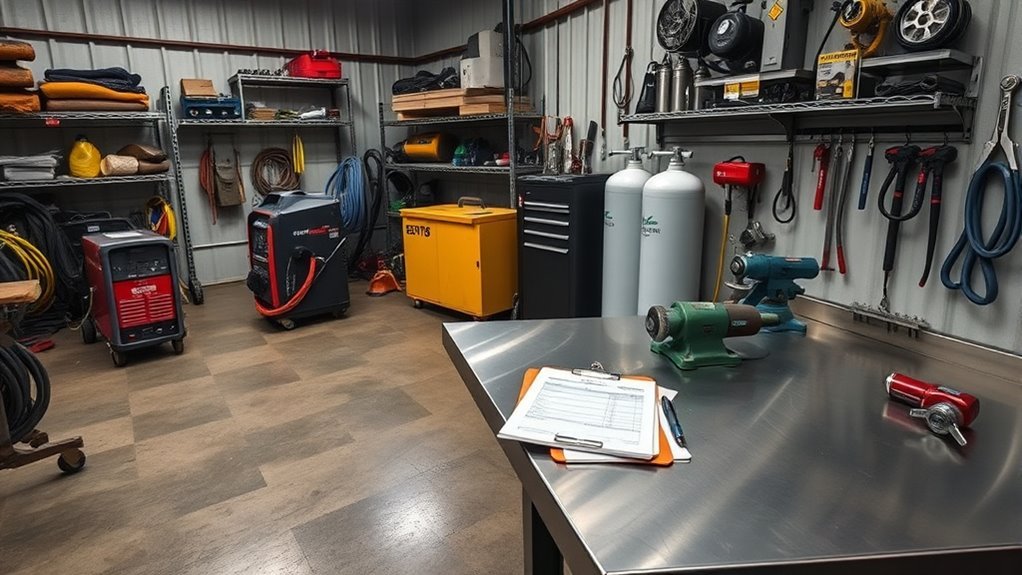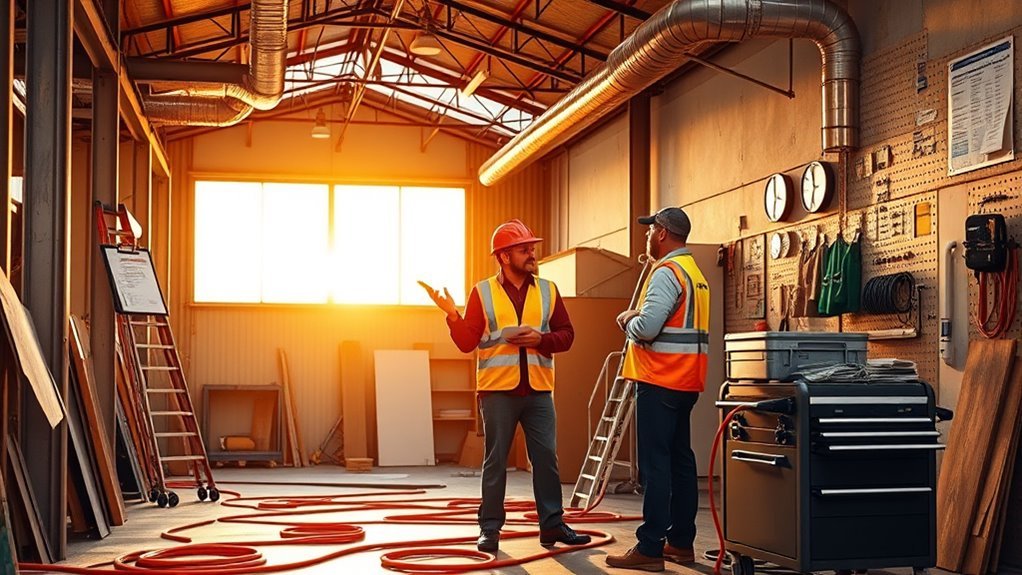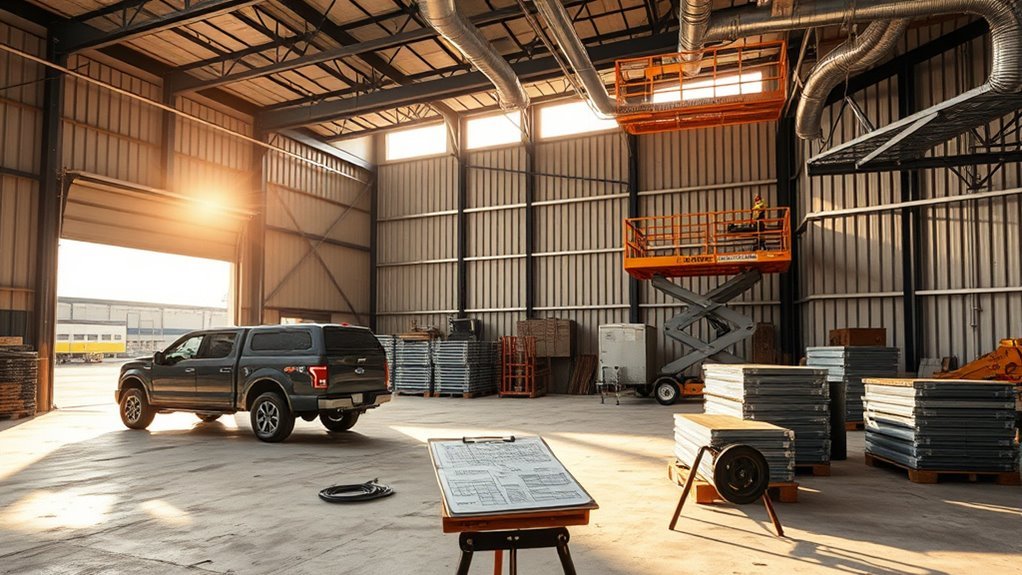Most people underestimate that ventilation and fire-suppression systems alone can add tens of thousands to your startup bill. You’ll want a clear budget framework covering land, construction, utilities, equipment, and safety systems, with standards-based specs for each. Permit, insurance, and certification costs must be layered in, and operating cash for staff and consumables is often overlooked—so keep going to see how those line items break down and where you can control costs.
Estimating Land, Construction, and Utility Expenses

When planning a welding shop, start by breaking costs into three clear categories—land, construction, and utilities—so you can budget accurately from day one.
You’ll perform a land evaluation first: expect purchase ranges roughly $50,000–$150,000 depending on location and market. Check zoning, access, soil, and service connections so you don’t incur unforeseen site remediation or hookup fees.
Next, apply disciplined construction budgeting: initial build-out can run from $75,000 to over $500,000 based on size, materials, and design standards. Itemize shell, insulation, ventilation, and code-driven fire protection to avoid scope creep.
Apply disciplined construction budgeting—expect $75K–$500K+ for build-out; itemize shell, insulation, ventilation, and fire protection.
Finally, quantify utility obligations: electrical, gas, and water vary with shop size and equipment use; larger shops may see winter utility peaks approaching $18,000 monthly.
Determine single-phase versus three-phase power needs up front, since service upgrades change both installation and ongoing costs. Use these precise inputs to produce a methodical, standards-aligned cost model before purchasing equipment.
Purchasing Welding Equipment and Shop Tools

After you’ve nailed down land, construction, and utilities, shift focus to the equipment and tools that will define your shop’s capabilities and recurring costs.
You’ll plan by grouping equipment types, conducting a cost comparison, and prioritizing purchases that match your intended services. Budget range for a typical shop runs $100,000–$300,000 depending on scale and quality.
Multi-process welders ($3,000–$8,000) and plasma cutters ($800–$2,500) form the core; stationary items and tooling add up quickly. PPE per welder averages $500–$1,500 at startup. If you offer mobile services, include vehicle and portable equipment costs of $15,000–$60,000.
- Core machines: multi-process welders, plasma cutters, and grinders
- Stationary equipment: welding tables, bandsaws, and fixturing
- PPE: helmets, gloves, jackets, respirators
- Mobile setup: vehicle, trailers, portable power
- Contingency: spare parts, calibration, and tooling
Choose standards-compliant equipment, compare total lifecycle costs, and stage purchases to preserve cash flow.
Safety, Ventilation, and Workshop Setup Costs

Because safety and ventilation form the foundation of a compliant welding shop, you should budget carefully for systems and layout that control fire risk, fumes, and workflow — typically $20,000–$80,000 depending on size and complexity. You’ll invest in ventilation systems, fire suppression, grounding, and PPE to meet safety regulations and reduce exposure. Plan zones for hot work, storage, and clean assembly to optimize workflow and limit ignition sources. PPE averages $500–$1,500 per welder; include lockers and inspection stations. Work with a qualified engineer to size ventilation systems and specify exhaust, make-up air, and filtration to meet code. Document procedures, maintenance schedules, and training to demonstrate compliance.
| Item | Typical Cost Range | Purpose |
|---|---|---|
| Ventilation systems | $8,000–$40,000 | Fume/gas control |
| Fire suppression | $3,000–$15,000 | Immediate hazard control |
| PPE per welder | $500–$1,500 | Personal protection |
| Layout/fit-out | $2,000–$10,000 | Workflow separation |
| Inspection/training | $500–$2,000 | Compliance documentation |
Permits, Insurance, and Certification Fees

Although the paperwork can feel routine, you should budget carefully for permits, insurance, and certifications because they’re fundamental to legal operation and client trust. Business registration and basic permits usually run $100–$500, professional certifications (like AWS) cost $500–$1,500 each, general liability insurance typically adds $600–$2,500 per year, and additional local or state licensing/compliance fees can total $1,500–$7,000.
You’ll submit permit applications, schedule certification exams, and secure insurance before taking on paid work. Prioritize certification importance to meet standards and win contracts.
- Confirm required permit applications and timelines with local authorities.
- List necessary professional certifications and associated costs per technician.
- Compare general liability quotes to set annual budgeting targets.
- Identify local/state compliance fees and renewals to avoid penalties.
- Document all approvals, insurance policies, and certificates for client verification.
Treat these costs as fixed infrastructure: factor them into startup capital, track renewal dates, and enforce compliance to sustain legal operation and protect your business reputation.
Ongoing Operating Expenses and Staffing Budgets

Now that your permits, insurance, and certifications are in place, you need to estimate the recurring costs that keep the shop running and your team paid.
Calculate utilities between $2,000 and $18,000 monthly based on size and equipment load. Factor annual general liability of $600–$2,500 and maintenance at 5–10% of equipment purchase price to preserve uptime. Track material volatility: steel runs roughly $800–$1,800 per ton; consumables add per-project variability.
For staffing strategies, budget skilled welders at $15–$30 per hour, plus payroll taxes and benefits—this often dominates monthly outlays. Use standardized labor categories and shift planning to align capacity with demand.
For expense management, implement monthly reconciliations, KPI thresholds for utility and maintenance variances, and a materials price-review cadence. Maintain a contingency reserve for price swings and unexpected repairs.
This disciplined, standards-focused approach keeps operating expenses predictable and supports scalable staffing budgets.
Frequently Asked Questions
How Long Does It Take to Build a Welding Shop From Start to Finish?
You can finish a welding shop in about 3–6 months, depending on scope. With strict project management and a clear construction timeline, you’ll methodically sequence permits, foundation, utilities, structural work, and interior outfitting to meet standards.
Can a Welding Shop Be Built in a Residential Zoning Area?
Yes — you can, but you’ll need to follow zoning regulations and secure residential permits; consult local planning departments, obtain inspections, limit noise, ventilation, fire safety, and hours, and document compliance before starting operations.
What Financing Options Are Available for New Welding Shop Owners?
You can pursue grant opportunities and loan options: federal or state small-business grants, equipment-specific grants, SBA 7(a) or CDC/504 loans, bank term loans, and equipment financing; you’ll document projections, collateral, and compliance rigorously.
How Much Value Does a Welding Shop Add to the Property?
Rugged, reliable retrofit boosts value: you’ll see property appraisal gains and improved investment return when a compliant, well-equipped welding shop’s documented systems, safety standards, and workflow efficiency enhance marketability and revenue potential.
Are There Eco-Friendly or Energy-Efficient Welding Shop Upgrades?
Yes — you can make your shop eco-friendly: install solar panels, use energy efficient equipment like inverter welders and LED lighting, add high-efficiency HVAC, recycle scrap, implement ventilation controls, and follow established energy-management standards.
Conclusion
You’ll stand at the doorway of your finished shop, tools humming like a ready crew, knowing the numbers you tracked — land, structure, equipment, safety, permits, and payroll — fit within your plan. Picture clean welds on sturdy joins and a safe ventilation breeze moving sparks away. By methodically budgeting each line item and keeping standards top priority, you’ll build a workspace that’s efficient, compliant, and ready for steady production.


